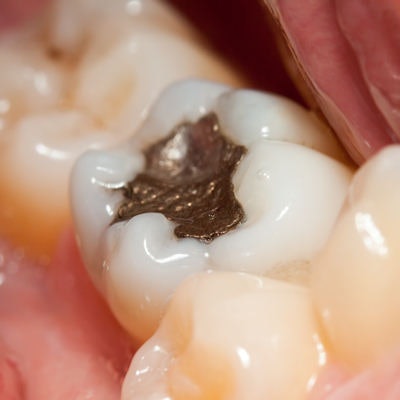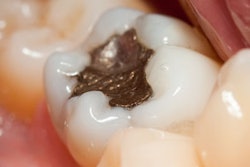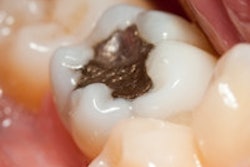
Should silver really be dentistry's gold standard? Dental fillings were linked to elevated blood mercury levels for thousands of people, according to a study in the journal Ecotoxicology and Environmental Safety.
Researchers from the University of Georgia and the University of Washington wanted to see if there was a correlation between the number of dental surface restorations and blood mercury (Hg) levels. Using data from nearly 20,000 U.S. residents, they found that having dental restorations significantly increased mercury levels but not bisphosphonate A (BPA) levels (Ecotoxicol Environ Saf, September 14, 2016).
"This study provides the scientific basis for the ongoing risk assessment of exposure to Hg and/or BPA from dental surface restorations, enabling dentists to select safe, effective restorative materials, especially for vulnerable populations, including children and pregnant women," wrote the study authors, led by Lei Yin, MD, PhD, an assistant research scientist at the University of Georgia.
The need for better amalgam studies
Dental amalgam is composed of about 50% elemental mercury (Hg). While dentistry has been treating patients with amalgam for more than 150 years, recent evidence has linked lower levels of some types of mercury to adverse effects, such as impaired neurological function and an irregulated immune system.
 Study authors Xiaozhong (John) Yu, MD, PhD, and Lei Yin, MD, PhD. Image courtesy of the University of Georgia.
Study authors Xiaozhong (John) Yu, MD, PhD, and Lei Yin, MD, PhD. Image courtesy of the University of Georgia.Because of this growing body of evidence against amalgam, some countries, including Norway and Sweden, have banned its use entirely. In 2015, a European committee recommended using amalgam alternatives for certain patients, such as young children and pregnant women. However, the U.S. Food and Drug Administration (FDA) has not changed its position on amalgam, saying that it is "safe for adults and children ages 6 and above."
"Although the FDA concluded that there is insufficient evidence to support an association between exposure to Hg from dental amalgams and potential adverse health effects in humans, it also admitted that this conclusion was based on the lack of accurate reference data for Hg exposures from dental amalgams available for a nationally representative population," the authors wrote.
Therefore, Dr. Yin and colleagues set out to create a large-scale study that accounted for covariates, such as age and seafood consumption, using a study population that mirrored the U.S. population.
Creating a representative study
The researchers used data from the 2003-2004 and 2011-2012 National Health and Nutrition Examination Surveys (NHANES). NHANES is conducted by the U.S. Centers for Disease Control and Prevention's Center for Health Statistics and is designed to provide nationally representative data about the health status of adults and children in the U.S.
The authors chose the 2003-2004 and 2011-2012 surveys specifically because a complete oral health examination and blood analysis were conducted during those years. Nearly 10,000 people participated in each survey.
In both surveys, data were collected on participants' total blood mercury levels (THg), inorganic mercury levels (IHg), and BPA levels, as well as age, race/ethnicity, gender, smoking, and fish/shellfish consumption history. Methyl mercury (MeHg) levels also were collected in the 2011-2012 survey but not the 2003-2004 survey.
The researchers used the NHANES data to analyze the relationship between blood mercury levels and the number of dental surface restorations. They found that all types of blood mercury levels were significantly higher for participants with dental surface restorations than without. These findings held true, even after adjusting for age, race/ethnicity, and fish consumption.

"We found that the number of DSRs [dental surface restorations] significantly increases blood THg and IHg after adjustment for confounding variables in both 2003-2004 and 2011-2012," Dr. Yin and colleagues wrote.
In addition, the researchers didn't find a significant relationship when they analyzed whether dental surface restorations increased levels of BPA, which is commonly found in composite restorations.
"Significant increases in blood THg, IHg, and MeHg in the subjects with DSRs are confirmed in a nationally representative population, a critical step in assessing the potential risk of adverse effects from dental restorative materials," the authors wrote, "but no association between dental fillings and urinary BPA was found."
How to further improve restoration research
It is important to note that although all types of blood mercury levels were increased with dental restorations, the average blood levels still fell below the safety threshold established by the World Health Organization and the U.S. Environmental Protection Agency. The authors suggested more research should to be conducted to examine potential adverse effects at lower blood mercury levels for the average healthy population and potentially vulnerable populations.
Among the study's shortcomings was that the type of dental filling and amount of time a participant had the dental filling were not recorded. Therefore, the researchers could not analyze the relationship between only amalgam fillings and mercury levels, or only composite fillings and BPA levels.
"New alternatives to amalgam are increasingly being used to reduce mercury exposure," the authors noted. "The observed decrease in blood THg in the group with more than 8 DSRs in recent years reveals the trend of change, and suggests a diversification from the use of amalgam fillings."
The authors recommended future studies continue to evaluate safe amalgam and BPA levels for both healthy and vulnerable populations.
"This study provides the scientific basis for the ongoing population-based risk assessment of exposure to Hg and/or BPA from dental surface restorations for the selection of safe, effective restorative materials, especially for sensitive populations," Dr. Yin and colleagues concluded.



















